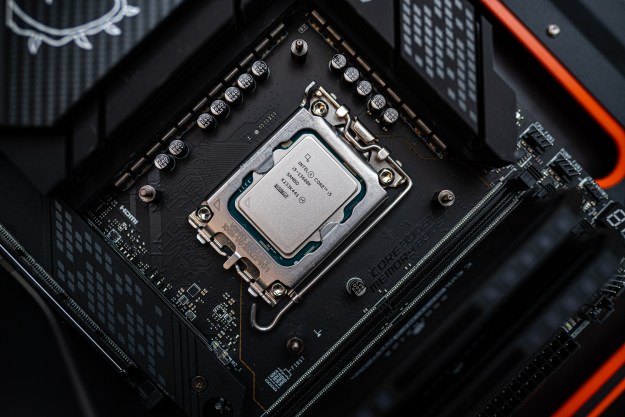
Chip maker Intel has taken the wraps off a new advancement in microprocessor design, using two new materials to built the insulating barriers and switching gates on its 45 nanometer transistors. The new designs will be incorporated into Intel’s next generation of Core 2 Duo, Core 2 Quad, and Xeon processor families, where they’re expected to keep the famous Moore’s Law on track: that the number of transistors on an integrated circuit doubles every two years. The new 45nm processors are being developed under the codename “Penryn,” and they’re expected to go into production in the second half of 2007.
For the last 40 years, chipmakers have been using silicon dioxide to make the transistor gates in semiconductors; however, engineers were rapidly approaching a limit to how far they could shrink the size of the gate before heat dissipation and wasted electrical current make the gates ineffective. The gate layer has been slimmed the gate layer down to a scant 5 atoms; however, Intel’s new insulator and gate materials will enable the company to continue shrinking transistor sizes while lowering power requirements and reducing power leakage. The Penryn chips use a hafnium-based high-k material in the gate dielectric; since that can’t be used with standard gate electrodes, Intel developed a secret new metal gate material to form the electrode. The result is a gate which provides a 20 percent increase in drive current and will enable the company to increase transistor density by about two times over the current generation of processors. The Penryn chips are also expected to consume about 30 percent less power than their predecessors: a server version will consume about 80 watts, desktop versions about 65 watts, and mobile chips a mere 35 watts.
Despite the historic significance of Intel’s technology announcement, industry watchers say Intel’s leap to a 45 nm process may only give the company a temporary lead on other chip makers like rival AMD—it basically keeps the current competition going rather than giving Intel an exponential advancement. AMD isn’t expected to match Intel’s move until 2008; historically, AMD’s research initiatives haven’t been as large-scale as Intel’s, but AMDs recent partnership with IBM provides access to considerable processor-making expertise.
Editors' Recommendations
- The best processors in 2024: AMD and Intel CPUs duke it out
- The best Intel processors for 2023
- The iPhone 15’s chip challenges Intel’s fastest desktop CPU — but there’s a catch
- Your next smartphone might have an Intel processor — seriously
- Intel’s 24-core laptop CPU might outclass desktop i9 processors


